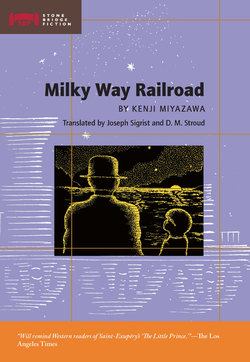Читать книгу Milky Way Railroad - Kenji Miyazawa - Страница 5
На сайте Литреса книга снята с продажи.
ОглавлениеAfternoon Class
“Well then, everybody, while it’s been called a river or a leftover spill of milk, can you tell me if this pale white thing is in fact a river?” The teacher pointed to the whitish Milky Way zone stretching from top to bottom of the star map that hung over the blackboard.
Campanella raised his hand. Four or five other students raised theirs. Giovanni started to raise his hand too, but quickly pulled it back. He felt sure that he’d read once in a magazine that the Milky Way was made up of stars, but recently he’d been in a continual daze, even in the classroom, and had neither free time to read books, nor books to read. He’d begun to feel that he didn’t understand anything for certain.
But the teacher, only too quickly, noticed. “Giovanni, you must know.”
Giovanni sprang to his feet, but found he had nothing to say. Zanelli squirmed around in the seat in front of him, looked back at Giovanni, and giggled. Giovanni turned beet red.
“If you examined the Milky Way with a large telescope, what would you find?”
They must be stars, thought Giovanni, but again he couldn’t come out with the answer.
The teacher looked frustrated for a moment, but then turned to Campanella. “Well, then, Campanella!” And Campanella, who had only just then raised his hand so promptly, got up only with hesitation, having nothing in fact to say.
The teacher looked intently and with some surprise at Campanella, but finally said, “Well then, that’s enough,” and pointed to the star map again himself. “If you looked at the pale white Milky Way through a powerful telescope, it would appear as a great number of little stars. Right, Giovanni?”
Giovanni, turning crimson, nodded, but at the same time his eyes brimmed over with tears. “But I knew!” he thought—and so, of course, did Campanella. It had been written up in a magazine he and Campanella had read, together at Campanella’s house. (Campanella’s father had a Ph.D.) Campanella had jumped up and brought a big book from his father’s study, and, opening it at the place marked “Milky Way,” the two of them had pored over a beautiful full-page photograph, completely black except for the little white points that covered it. “Campanella could hardly have forgotten something like that,” thought Giovanni. “If he didn’t answer, it must mean that he’s thinking how hard I have to work morning and night. I’ve given up playing with the others when I come to school, or even talking much to Campanella. So, when he didn’t answer on purpose, he must have been covering up for me.” Giovanni felt an unbearable wave of sadness sweep over him, both for himself and for Campanella.
“So then,” the teacher was saying, “if we think that this heavenly river is really a river, all of those little stars are like the sand and gravel in the riverbed.”
“So then,” the teacher was saying, “If we think that this heavenly river is really a river, all of those little stars are like the sand and gravel in the riverbed. Or, if we think of the Milky Way as a great flow of milk, then it resembles a heavenly river even more. The stars are specks floating in the milk like drops of oil. And if you ask what compares to the water or milk of the river, we answer, ‘the speed of light,’ ‘the vacuum.’ The sun and the earth are floating in it. In short, we are floating in the water of the Milky Way River. And if we look in all directions from where we are within this watery space, we see the bluish tint of deep water. Now, down at the bottom, deep and far away, the stars are thickly concentrated, and so seem white to us. Look at this model.”
The teacher pointed to a large, two-faced convex lens containing many shining grains of sand. “The galaxy is shaped like this. Each of these bright pebbles, like our sun, is a shining star. Our sun is just about in the middle, and our earth is nearby. At night, you, who are standing, let us say, in the center of the lens, should take a look around. This part of the lens is thin so you can see only a few shining pebbles or stars. Over here and here, the glass is thick and the pebbles—the stars—are numerous. The faraway ones look white to us.
“Well then, so much for today’s discussion of that great heavenly river, the Milky Way. The next questions, about how big the lens is and about the various stars within, will be our next science lesson, I guess. For now, time’s up. Today is the Milky Way Festival, so all of you go outside and look at the sky tonight. That’s all. Close your books and notebooks.”
And for a moment the room was full of the sound of desks opening and closing, and of books piling up. Then everyone stood to attention and left the classroom.
